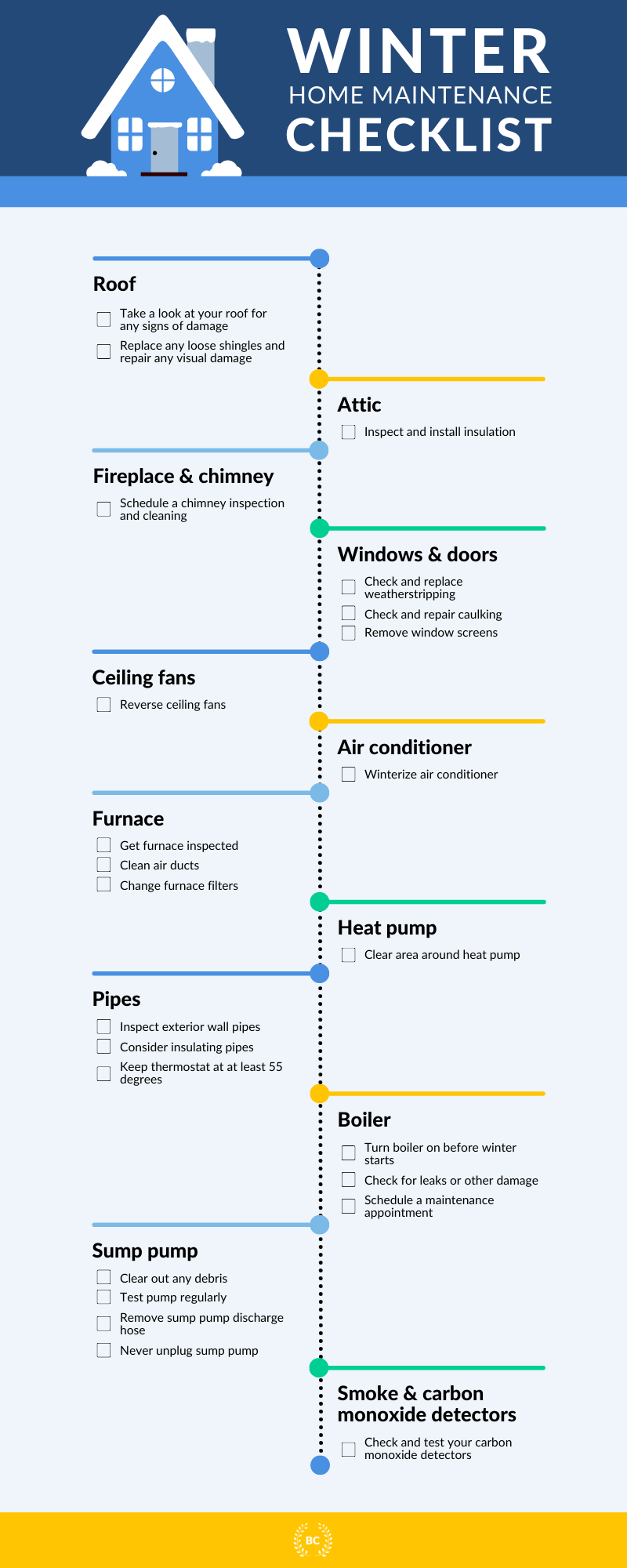Winter Home Maintenance Checklist 2022
When the weather starts getting colder and we all retreat into our homes to stay warm, it’s important to make sure that your house is in good condition to withstand the outdoor elements. Make sure you check the following systems and parts of your home to prepare for winter weather:
Roof
Attic
Fireplace and chimney
Windows and doors
Ceiling fans
Air conditioner
Furnace
Heat pump
Pipes
Boiler
Sump pump
Smoke detectors and carbon monoxide detectors

Roof
The winter months can bring unpredictable weather beyond snowfall, such as rain and/or high winds. For that reason, it’s a good idea to visually check out your roof before the weather changes. You may not even have to climb up onto your roof — just taking a look at it from the ground can give you a quick visual of its condition. If you’d like to do a more comprehensive check of your roof, you can climb up and check the shingles and other areas of concern.
- Take a look at your roof for any signs of damage. Look out for any signs of damaged, buckled, or missing shingles.
- Replace loose shingles and repair any visual damage.
It is important to visually inspect your roof, particularly if you live in an area that experiences snowfall. The cycle of snow accumulating, freezing, and thawing can be damaging to your roof; check your roof once the winter season has ended in case it has incurred any damage.
The Top Home Warranty Companies



Attic
A lot of heat in a home can be lost through a poorly insulated attic. It is important to inspect your attic insulation and assess whether or not it needs to be replaced.
- Inspect and install insulation.
Inspecting insulation will typically require that you get up into your attic and then measure how much insulation you have. Insulation level recommendations will vary depending on where you live, but a good rule of thumb is as follows: if your insulation measures below your joist, it probably isn’t enough insulation.
A standard joist is typically measured at 2” X 8”, and you should have anywhere from 13 to 18 inches of insulation, depending on your location.
For more information regarding insulation, check out this insulation guide from Insulation Institute.
Fireplace and chimney
While the weather outside is frightful, the fire will only be delightful if your fireplace and chimney are in good repair.
- Schedule a chimney inspection and cleaning.
Debris, soot, leaves, and even bird nests can accumulate in your chimney, which could cause chimney fires if not swept away. Thus, it’s important to get your chimney inspected and cleaned for the winter months.
Windows and doors
If heat is escaping your home, or cold air is entering, windows and doors are typically the culprit. For that reason, it’s important to prepare your home for colder weather by doing the following:
- Check and replace weatherstripping.
- Check and repair caulking, but be careful where you caulk. You don’t want to cut off small openings necessary for air flow and/or drainage. It is recommended that you don’t caulk certain exterior fixtures of your home, as well as on operable windows and doors that are in frequent use. In most cases, weatherstripping will be the better option, especially for windows and doors.
- Remove window screens. Doing so can maximize natural light, in addition to protecting your window frames from damage caused by debris or snow getting trapped in between the screen and your windows.
Ceiling fans
It can be easy to forget about your ceiling fans, because you obviously wouldn’t be running them through the winter anyways. But in terms of winter preparation, your ceiling fans aren’t something you should ignore.
- Reverse your ceiling fans.
Reversing your ceiling fans can give your heating system a helping hand by forcing warm air down that has risen. This could allow you to lower your thermostat, helping you save more energy and cut back on heating costs.
Air conditioner
You likely won’t be using your air conditioning system during the cold winter months, but that doesn’t mean you should just turn it off and ignore it.
- Winterize your air conditioner.
According to Climate Care, there are five steps to winterize your air conditioner:
- Turn your air conditioner off.
- Clean units.
- Change the filters.
- Check pipe insulation.
- Cover your air conditioner.
You may be able to clean and prepare your air conditioner for the winter months by yourself, but it can also be helpful to have a technician come check, clean, and cover it, ensuring that it will remain in good condition throughout the winter.
Furnace
One of the most important things to take care of before the winter months is your furnace.
- Get your furnace inspected.
- Clean air ducts.
- Change furnace filters.
Getting your furnace inspected early on can ensure that you catch any potential problems, or even buy a new furnace, if needed, before the cold sets in. You may be able to easily clean furnace air ducts and change filters easily by yourself, but it is best to have a professional come to inspect your furnace to make sure that everything is working properly.
And while you are in the basement, it is a good idea to double check water entry points. If you are concerned about potential flooding, waterproofing the basement may be a good idea.
Heat pump
You can follow some of the following steps to prepare your heat pump for the winter months:
- Clear the area around your heat pump.
- Change your heat pump filter.
Pipes
Pipes exposed to cold air can burst, which can cause a lot of damage to your home. So you’ll want to take a few steps to keep your pipes from freezing:
- Inspect exterior wall pipes.
- Consider adding insulation to your pipes.
- Keep your thermostat at at least 55 degrees. This is especially important if you’re going to be out of town.
Boiler
You wouldn’t want your boiler breaking down during the winter months, so you can take some of the following steps to make sure it’s in good condition before it starts getting cold:
- Turn it on before winter starts.
- Check for leaks or any other damage.
- Schedule a boiler maintenance appointment.
Sump pump
A sump pump is used to detect water levels and keep them from rising. Typically located in the basement of a home, it is important to ensure that your sump pump is in good condition or else you could risk a flood. Take some of the following steps to properly winterize your sump pump:
- Remove the sump pump discharge hose. If water freezes inside the hose, it would render the pump unusable until water thaws.
- Clear out any debris.
- Test the pump regularly. Simply run some water through to ensure that everything is working properly.
- Never unplug your sump pump.
Smoke detectors and carbon monoxide detectors
Having functioning smoke detectors and carbon monoxide detectors is important all year round. However, during the winter months there is less fresh air flow in your home because your windows will be closed to keep cold air out. This can result in a higher risk of carbon monoxide build-up.
- Check your smoke detectors and carbon monoxide detectors.
The bottom line
Most maintenance can be done visually and quickly. However, while there are many inspections and fixes that you may be able to do yourself, it can always be a good rule of thumb to schedule professional maintenance, especially for home systems.
For further protection, homeowners may want to look into purchasing or renewing their home warranty to ensure full coverage amidst the harsh winter months.
It is important to ensure that all your home systems are functioning properly when winter sets in. But some maintenance can even save you more money on your energy bills, like reversing your ceiling fans and checking your attic insulation, which can both help regulate the heat in your home.
Related Articles
Home Warranty
What Does a Home Warranty Cover?
By Best Company Editorial Team
October 2nd, 2025
Home Warranty
American Home Shield Cost & Coverage Details
By Best Company Editorial Team
August 22nd, 2025
Home Warranty
Cheapest Home Warranty Companies of 2025
By Best Company Editorial Team
October 2nd, 2025
Get Our Newsletter - Be in the Know
Sign up below to receive a monthly newsletter containing relevant news, resources and expert tips on Home Warranty and other products and services.
We promise not to spam you. Unsubscribe at any time. Privacy Policy